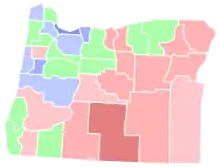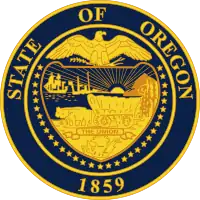Politics of Oregon
Like many other U.S. states, the politics of Oregon largely concerns regional issues.[1] Oregon leans Democratic as a state, with both U.S. Senators from the Democratic party,[2] as well as four out of Oregon's five U.S. Representatives.[3] The Democratic candidate for president has won in Oregon in every election since 1988.[4] Both houses of Oregon's legislative assembly have been under Democratic control since the 2012 elections.[5]
The state is broken up into two main geographically separate political areas: the liberal cities of the Willamette Valley and the rest of the state, whose voters are moving from conservative to libertarian.[1][6] While about 47% of the population of Oregon lives in the Portland metropolitan area as of 2013,[7][8] the state has a rural population with generally conservative views on state taxes. On most other issues, however, the state leans considerably left, including on public health care,[9][10] recreational and medical marijuana,[11] assisted dying,[12] and environmental protections.[13]
History
For the first half of the 20th century, Oregon was the most consistently Republican west coast state.[14] In 1954, the upset of incumbent Republican Senator Guy Cordon by Democrat Richard L. Neuberger, along with Democratic wins in the U.S. House and statewide races and pickups of fourteen and two seats in the state House and Senate, respectively, signaled the beginning of a shift towards the Democratic Party.[14] The last Republican governor of Oregon was Victor G. Atiyeh, who served from 1979 to 1987.[15][16] Since 1988, Oregon voters have consistently favored Democratic candidates for most major elected positions, including the U.S. presidency.
The longest-serving governor in Oregon history is John Kitzhaber, who served two consecutive terms as governor, then left office before returning to win a third term in 2010 ahead of Republican and former Portland Trail Blazer Chris Dudley and the 2014 election against Republican Dennis Richardson. Kitzhaber resigned in February 2015 after allegations of financial impropriety involving his partner and girlfriend, Cylvia Hayes, and certain lobbying efforts.[17][18][19]
Political geography
Oregon's politics are largely divided by the Cascade Mountains, with much of western Oregon leaning Democratic and eastern Oregon leaning Republican.[20] The rapidly-growing area around Bend in Central Oregon has created Democratic voter registration majorities in Deschutes County.[21] Republicans have some strongholds in the western part of the state outside of larger cities.[22] Linn County, between the liberal cities of Eugene and Salem, has voted for the Republican presidential candidate in every election since 1980.[23] Southern Oregon is also a Republican stronghold, except in Jackson County, which frequently votes for both Republican and Democratic candidates.
In the 1998 gubernatorial election, the only county won by Republican candidate Bill Sizemore was Malheur County. Because of the concentration of population in Portland and the Willamette Valley, Gov. Kate Brown, a Democrat, won the 2018 election despite carrying only 7 of Oregon's 36 counties.
Based on voting data from the 2012 presidential election, Ontario in Malheur County was rated as the most Republican in the state.[24] Gresham in Multnomah County was rated as the most Democratic.[25]
In the 2016 presidential election, Democrat Hillary Clinton received 50.07% of the vote, while Republican candidate Donald Trump received 39.09%. Trump performed best in Lake County, winning 77% of the 5,400 registered voters. Hillary Clinton performed best in Multnomah County, where she received 73% of the vote. Libertarian candidate Gary Johnson performed best in Gilliam County, where he received 8% of the vote.
The last time a Democrat won every county in the state in a presidential election was in 1936, when Franklin D. Roosevelt carried all counties. The last time a Republican accomplished this feat was in 1928, when every county was won by Herbert Hoover. The last time a third-party candidate won any county was in 1912, when Theodore Roosevelt carried Clatsop, Columbia, Jackson, and Washington counties on the Progressive ticket. Independent candidate Ross Perot won 24.7% of the 1992 presidential vote in Oregon, but carried no counties.
Key issues
Key issues in Oregon include:
- Employment
- Environmental protection[1]
- Native American relations (particularly in respect to gambling and casinos)
- Public health care
- Public transportation
- School funding
- Taxes
- Land use
Population's political ideology
| Year | Republican | Democratic |
|---|---|---|
| 2020 | 40.3% 958,448 | 56.4% 1,340,383 |
| 2016 | 41.1% 782,403 | 51.7% 1,002,106 |
| 2012 | 42.15% 754,175 | 54.24% 970,488 |
| 2008 | 40.40% 738,475 | 56.75% 1,037,291 |
| 2004 | 47.19% 866,831 | 51.35% 943,163 |
| 2000 | 46.46% 713,577 | 47.01% 720,342 |
| 1996 | 39.06% 538,152 | 47.15% 649,641 |
| 1992 | 32.53% 475,757 | 42.48% 621,314 |
| 1988 | 46.61% 560,126 | 51.28% 616,206 |
| 1984 | 55.91% 685,700 | 43.74% 536,479 |
| 1980 | 48.33% 571,044 | 38.67% 456,890 |
| 1976 | 47.78% 492,120 | 47.62% 490,407 |
| 1972 | 52.45% 486,686 | 42.33% 392,760 |
| 1968 | 49.83% 408,433 | 43.78% 358,866 |
| 1964 | 35.96% 282,779 | 63.72% 501,017 |
| 1960 | 52.56% 408,060 | 47.32% 367,402 |
| 1956 | 55.25% 406,393 | 44.75% 329,204 |
| 1952 | 60.54% 420,815 | 38.93% 270,579 |
Similar to the West Coast states of California and Washington, Oregon has a high percentage of people who identify as liberals. A 2013 Gallup poll that surveyed the political ideology of residents in every state found that people in Oregon identified as:[27]
A 2008 analysis by political statistician Nate Silver on states' political ideology noted that the state's conservatives were the most conservative of any state (more so than Utah or Tennessee) and that the state's liberals were more liberal than any state (more so than Vermont or D.C.).[28]
Political parties

According to the state's election agency, as of December 2019, there were 2,813,802 registered voters in Oregon, with their political party affiliations (highest to lowest) as follows:[29]
- 34.4% Democratic Party
- 34.0% "Non-affiliated" with any party
- 24.9% Republican Party
- 4.4% Independent Party
- 0.7% Libertarian Party
- 0.3% Working Families Party
- 0.3% Pacific Green Party
- 0.1% Constitution Party
- <0.1% Progressive Party
- 0.6% with other political parties
See also
References
- Cohen, Micah (August 16, 2012). "Oregon, Sitting at the Border of Safe and In Play". FiveThirtyEight. Retrieved August 6, 2014.
- "Oregon's United States Senators". Oregon Blue Book. Oregon Secretary of State. Retrieved July 31, 2014.
- "Oregon's United States Representatives". Oregon Blue Book. Oregon Secretary of State. Retrieved July 31, 2014.
- "Votes Cast in Oregon for U.S. President 1860-2016" (PDF). Oregon Blue Book. Oregon Secretary of State. Retrieved July 31, 2014.
- "2012 Election Results: Oregon Legislature". OregonLive.com. Retrieved November 7, 2012.
- Yardley, William (May 19, 2008). "A Shift in Voters, but Oregon Still Embraces the Unconventional". The New York Times. Retrieved July 27, 2014.
- "State & County QuickFacts: Oregon". U.S. Census Bureau. Archived from the original on February 24, 2016. Retrieved July 27, 2014.
- "Update of Statistical Area Definitions and Guidance on Their Uses" (PDF). The White House. November 20, 2007. p. 45. Retrieved July 27, 2014.
- "Oregon Health Plan". State of Oregon. Retrieved July 31, 2014.
- Vekshin, Alison (May 19, 2014). "Doctor-Governor Kitzhaber Imperiled by Oregon Insurance Failure". Bloomberg Businessweek. Retrieved July 31, 2014.
- "Oregon Medical Marijuana Program (OMMP)". Oregon Health Authority. State of Oregon. Retrieved July 31, 2014.
- Oregon Death with Dignity Act
- McCaulou, Lily Raff (December 10, 2012). "Oregon's political divide". The Bulletin. Bend, Oregon. Retrieved July 27, 2014.
- Swarthout, John M. (December 1954). "The 1954 Election in Oregon". The Western Political Quarterly. The Western Political Quarterly. 7 (4): 620–625. doi:10.2307/442815. JSTOR 442815.
- "Governor Victor G. Atiyeh's Administration: Biographical Note". Oregon Secretary of State. Retrieved July 31, 2014.
- Turner, Wallace (May 18, 1982). "Oregon's Governor Leading 6 in Polls". The New York Times. Retrieved July 31, 2014.
- "Governor's Records Guides - Governor John Kitzhaber". Oregon State Archives. Oregon Secretary of State. Retrieved July 31, 2014.
- Kaplan, Thomas (August 2, 2010). "Candidate's Platform: Jobs. Experience: N.B.A." The New York Times. Retrieved July 31, 2010.
- Nakamura, Beth. "Governor John Kitzhaber announces his resignation". The Oregonian. Retrieved February 13, 2015.
- Cohen, Micah (August 16, 2012). "Oregon, Sitting at the Border of Safe and In Play". FiveThirtyEight. The New York Times. Retrieved January 3, 2016.
Oregon, like Wisconsin, is an ideologically polarized state. The Cascade Mountains are a convenient dividing line, politically and geographically.
- Bureau, Gary A. Warner Oregon Capital. "Big turnout, big spending as election finish line looms". The Bulletin. Retrieved 2020-10-30.
- "Oregon Election Results 2016: President Live Map by County, Real-Time Voting Updates". Election Hub. Retrieved 2020-10-30.
- Presidential Election of 1976 by County
- White, Carrie (June 14, 2016). "These Are The 10 Most Conservative Cities In Oregon". RoadSnacks. Retrieved January 7, 2017.
- White, Carrie (June 14, 2016). "These Are The 10 Most Liberal Cities In Oregon". RoadSnacks. Retrieved January 7, 2017.
- Leip, Dave. "Presidential General Election Results Comparison - Oregon". Retrieved July 31, 2014.
- Swift, Art (January 31, 2014). "Wyoming Residents Most Conservative, D.C. Most Liberal". Gallup. Retrieved July 31, 2014.
- Silver, Nate (May 17, 2008). "Oregon: Swing State or latte-drinking, Prius-driving lesbian commune?". FiveThirtyEight.com. Retrieved February 24, 2010.
- Oregon State Elections Division (2020-01-09). "Voter Registration Comparison by County - December 2019" (PDF). Oregon.gov. Oregon Secretary of State. Retrieved 2020-01-18.
